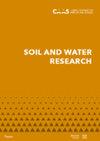Chemical relationships in earthworm casts of two urban green spaces indicate the earthworm contribution to urban nutrient cycles
IF 1.7
4区 农林科学
Q4 SOIL SCIENCE
引用次数: 0
Abstract
Due to the earthworms’ implications in nutrient cycles through their burrowing and casting activity, earthworms are worth considering when urban biogeochemical cycles are analysed. Several chemical parameters and their relationships were analysed in earthworm casts of two urban parks, namely the pH, total organic carbon (TOC), total nitrogen (Nt), plant available phosphorus (P), plant available potassium (K), and calcium water soluble (Ca). It was statistically significantly found that the TOC, Nt, P and K are reciprocally determined in the earthworm casts: 74.4% of the pH variability is co-determined by the N, P, K, TOC, and Ca contents; 95.9% of the Nt variability is co-determined by the pH, P, K, TOC, and Ca contents; 95.4% of the P variability is co-determined by the pH, N, K, TOC, and Ca contents; 94.5% of the K variability is co-determined by the pH, N, P, TOC, and Ca contents; 86.6% of the TOC variability is co-determined by the pH, N, P, K, and Ca contents. This study revealed the complexity of the chemical relationships inside earthworm casts, their reciprocal dependencies, and highlighted the complexity of the earthworms’ contribution to biogeochemical cycles in urban areas. Our findings propose earthworms as indicators of the integrative conservation management of urban ecosystems.两个城市绿地蚯蚓粪便的化学关系表明蚯蚓对城市养分循环的贡献
由于toÂ蚯蚓通过它们的挖洞和铸造活动对inÂ营养循环的影响,蚯蚓在分析城市生物地球化学循环时值得考虑。分析了inÂ蚯蚓粪便ofÂ两个城市公园的pH、总有机碳(TOC)、总氮(Nt)、植物速效磷(P)、植物速效钾(K)和水溶性钙(Ca)等化学参数及其相互关系。ItÂ具有统计学显著性,发现TOC、Nt、PÂ和K相互决定inÂ蚯蚓铸型;74.4% of pH变异性isÂ共同决定by N、P、K、TOC和Ca含量;95.9% of Nt变异isÂ共同决定by pH、P、K、TOC和Ca含量;95.4% of PÂ变异度isÂ共同决定by pH、N、K、TOC和Ca含量;94.5% ofÂ钾变异度isÂ共同决定by pH、N、P、TOC和Ca含量;86.6% of TOC变异isÂ共同决定by pH、N、P、K和Ca含量。本研究揭示了蚯蚓粪便内部化学关系的复杂性ofÂ及其相互依赖关系,并强调了蚯蚓贡献的复杂性of toÂ生物地球化学循环inÂ城市地区。研究结果提出了蚯蚓asÂ指标ofÂ城市生态系统综合保护管理ofÂ。
本文章由计算机程序翻译,如有差异,请以英文原文为准。
求助全文
约1分钟内获得全文
求助全文
来源期刊

Soil and Water Research
Water resources, Soil Science, Agriculture-WATER RESOURCES
CiteScore
4.60
自引率
0.00%
发文量
26
审稿时长
>12 weeks
期刊介绍:
An international peer-reviewed journal published under the auspices of the Czech Academy of Agricultural Sciences and financed by the Ministry of Agriculture of the Czech Republic. Published since 2006.
Thematic: original papers, short communications and critical reviews from all fields of science and engineering related to soil and water and their interactions in natural and man-modified landscapes, with a particular focus on agricultural land use. The fields encompassed include, but are not limited to, the basic and applied soil science, soil hydrology, irrigation and drainage of lands, hydrology, management and revitalisation of small water streams and small water reservoirs, including fishponds, soil erosion research and control, drought and flood control, wetland restoration and protection, surface and ground water protection in therms of their quantity and quality.
 求助内容:
求助内容: 应助结果提醒方式:
应助结果提醒方式:


